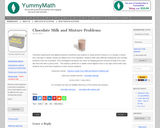
For this lesson, students set up and solve equations to solve mixture problems.
- Subject:
- Mathematics
- Material Type:
- Activity/Lab
- Provider:
- YummyMath
- Date Added:
- 04/25/2017

For this lesson, students set up and solve equations to solve mixture problems.
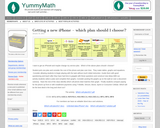
For this activity, students select a cellular plan considering the cost of the phone and plan over time. Students create tables, graphs, and equations and compare paying for the phone up front or with installment payments using popular cellular companies.
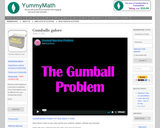
For this activity, students view a video of a gumball machine and cogitate, estimate, and calculate to answer questions about the gumballs. (Note: There is no sound until about the 1:00 mark).
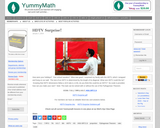
For this activity, students use the Pythagorean theorem to solve problems.
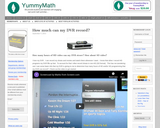
For this lesson, students determine the number of hours of HD and/or SD programming a DVR can record.
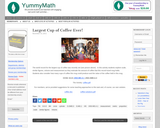
For this activity, students explore scale, similar figures, volume and measurement as they estimate the amount of coffee that the largest coffee mug in the world can hold. Students also calculate how many cups of coffee the mug could produce and the value of the coffee held in the mug.
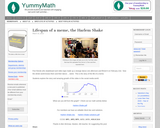
For this activity, students study data to answer questions.
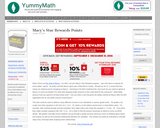
For this activity, students focus on inputs, outputs and the functional relationship between variables to answer questions about Macy's Star Rewards program.
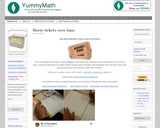
For this lesson, students view changes in movie ticket prices over the past 30 years. Students use scatter plot to analyze rates of change, make predictions about future ticket costs, and make guesses about past costs and try to create lines of best fit.

For this activity, students use data to predict the total gross income of movies from opening weekend and to respond to questions.
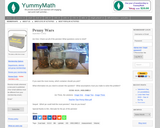
For this activity, students view an image of three different sized containers holding pennies to answer questions.

For this lesson, students make predictions about the men's and women's basketball tournament brackets and explore their odds at picking a perfect bracket.

For this activity, students use art to use the Pythagorean theorem and to understand irrational numbers.

For this activity, students examine the pay of presidents since 1789 and use the data to create a scatter plot and answer questions.
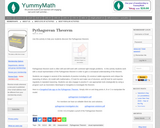
For this activity, students work with a visual representation of the Pythagorean theorem in order to gain a conceptual understanding of the theorem.
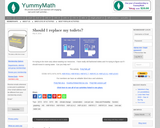
For this activity, students determine if buying a new toilet will save them money.

For this lesson, students use slope and the Pythagorean theorem to find the percent of grade change.

For this lesson, students practice using scientific notation as they calculate the cost of Super Bowl commercials. Students decide who the marketing was geared toward after expressing their opinions about the ads.

For this activity, students compare the cost of buying disposable versus cloth diapers and estimate how much diapers cost their parents. Students consider how much money they will spend on diapers when they have a baby.
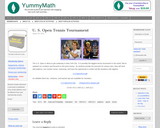
For this activity, students use reasoning and number sense, and model real-life situations with algebra.